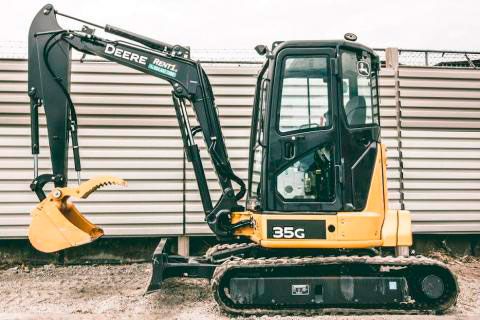John Deere Mini Excavator Safety Tips
According to government studies, hundreds of people die each year from accidents related to the performance of excavators – either operators or innocent bystanders. The greatest risk of harm is either being struck by the machine itself, or one of its components like the bucket or blade. Why do such accidents happen? The main cause of excavator-related injuries is lack of safety and operator training, failure to install or secure accessories properly, maintenance failures, shoddy work practices, and lack of property safety equipment and clothing. Operator and machinery-related issues can lead to injury, but manufacturers such as John Deere have addressed these with innovative and proven safety features: a large cab offering an unobstructed view of the work site; auto-idle option for the engine; pattern changer; foldable pedals; wear-compensating quick coupler; and steps and safety rails adjacent to the cab.

Safety Tips for the Job Site
- Call the local utility or municipality to make sure underground or hidden lines – gas, water, electric, cable – are properly identified. Each type of utility is designated by a different color flag.
- John Deere specifies the maxim grades or slopes at which their mini excavators can be operated. Do not exceed those recommendations.
- The John Deere 35G or other models should be positioned a safe distance from any trenches or other dig locations.
- Note the location of the excavator relative to the job site.
- The work area should always be clear of co-workers or bystanders before operating your John Deere Mini Excavator.
- Always travel in a straight line between two points, preferably over the flat or uniform terrain.
- When you must steer in another direction, proceed gradually but make sure the route is clear.
- Before starting work, do you know the location of inclines, trenches, uneven terrain, slopes, or other site features that could be a risk?
- Your John Deere Mini Excavator is designed to be operated by one person, and should not be used to transport others.
- Only drive or otherwise operate the machinery from the seat inside the cab, and when secured by the seat belt.
- It should go without saying, but do not drive or operate machinery if you are taking prescription medicine or have ingested anything that would impair your hearing, vision, reflexes, or decision-making.
- While you may have called the local utility to mark hidden power lines, do you know where other low-hanging or disconnected power lines may be located? What about water hydrants or above-ground utility enclosures?
- Note the presence and location of bridges, miscellaneous structures, overhead objects, tree limbs, or anything else that would be an operational risk.
- Do you have to traverse a slope? If so, drive vertically with the excavator’s bucket and boom extended for more stability – or if you need to grab the ground if the machine slips.
- The boom or bucket also should be extended for added stability when traveling downward. If the grade you are working on is steep, the excavator’s forward motion when combined with the bucket and boom can help keep the machine in one location, or even pull it forward.
- You can practice driving down a slope or sideways by placing the bucket with its flat side touching the ground. This means you can control how quickly you go downhill and move with added stability.
- Keep in mind that your John Deere Mini Excavator is a flexible brute when it comes to digging, but the task is easier when using the bucket if you are on level ground.
Finally, all excavated dirt or other site debris should be deposited in a pre-determined location away from where you are digging and not near the trench edge. This is advised because you do not know what is beneath your tracks and will be able to backup if an emergency happens.
Equipment Operator Safety or Training Tips
- Make sure equipment operators are trained in how to use the John Deere 35G or other excavators, and always follow manufacturer instructions.
- If you are a supervisor-level employee or above tasked with training, it is your responsibility to stay aware of workplace safety standards and any industry or government-mandated programs for your employees.
- If not already done so, make sure all excavator controls, access panels, and components and accessories are clearly labeled with safety or operator instructions.
- Standard or optional components should only be installed and maintained by following John Deere-provided instructions.
- Quick-disconnect buckets or other attachments should be secured before starting work. Also, make sure you know how to use positive locks for such components.
- Operators and other staff should be trained to make a complete visual inspection of equipment and the job site before starting work.
- Always use safety belts or harnesses in the cab as provided by John Deere.
- The boom should be lowered to the ground to a safe position before the excavator is shut down.
- Operators and other staff should be supplied with safety clothing and other equipment, such as gloves, goggles, headgear.
- Once in the cab, go through a standard checklist: indicator lights & gauges, the control panel itself.
- Does the bucket and boom work like they should?
- As the operator, you are responsible for completing your job on time and safely, and should have a plan to accomplish your goals before starting work.
Common Sense Goes a Long Way
Your excavator needs to be cleaned every day it is in use. Guess who has the responsibility? Right, you! If you are cleaning the bucket with back and forth motions, make sure you are in a safe area away from others. Proceed with caution: Force-cleaning with back and forth movements should only be done a few times to avoid mechanical damage or ruining them. Other tips worth mentioning:
- Yes, you can clean the bucket manually, but only if the excavator is shut off and parked in a safe location on level ground. The bucket also needs to be locked so you can rake out dirt or other debris or when using a pressure washer.
- Only attach or detach hydraulic couplings when the machine is off and on a level surface.
- Use caution when attaching or removing other accessories like augers, backfill blades, hydraulic hammers, or other components.
- It bears repeating that the mini excavator should operate from a level surface whenever possible; the same applies to the end of the workday, with the bucket and blade resting on the ground if possible.
- The engine should always be set to idle before turning off the ignition and removing the key.
- Before stepping from the cab, ensure to lock the pilot shutoff lever.
- It may have been a long day and you are in a hurry, but use care when leaving the cab and keep two hands on the safety rails when stepping down.
- Make sure the cab door and other access panels are locked at the end of the day.
- Top of the fuel and other fluids as recommended.
- When moving the excavator between locations, the trailer should be on the level ground before you drive the excavator up the ramp onto the trailer
- Keep the trailer bed clean.
- Use “chop blocks” for each wheel to keep the trailer from moving before you drive the excavator onto it.
- Remember: Ramps or a loading dock are your best friend when driving the excavator onto a trailer, so you can deliver it elsewhere.
- Your John Deere Mini Excavator should always be driven to the center of the trailer bed, with the bucket and blade lowered and touching the surface.
- With the excavator located on the trailer, shut it down and follow all recommended safety instructions from John Deere. This includes securing the blade, bucket, and track frame to the trailer bed using recommended cables or chains.
- Before driving the trailer away, do you know the route from one location to the next? Always measure the total height – from the top of the excavator to the ground. This will inform you as to any tunnels or overpasses you may need to avoid during transport.
- Now that you have reached your drop-off point, raise the excavator boom and blade to a 90-degree angle before driving the machinery down the ramp. And always drive slowly.
No matter your experience, it never hurts to read through product or safety documentation before operating your John Deere. Time spent in this regard will inform you how to safely operate and maintain the machinery and may provide reminders or insight that you missed before. John Deere has a long and distinguished history of manufacturing the highest quality excavators and other machinery and prides itself on creating a clearly understandable machine decals and safety manual, an Operation and Maintenance Manual, and an Operator’s Handbook, to give you clear operation and maintenance instructions. Your knowledge and workplace awareness, combined with John Deere product information, give you the means to safely operate heavy equipment. But the end result is your responsibility. Finally, know the excavator’s capabilities, worksite particulars, and always hold all manufacturer-recommended safety and maintenance procedures in high regard.

